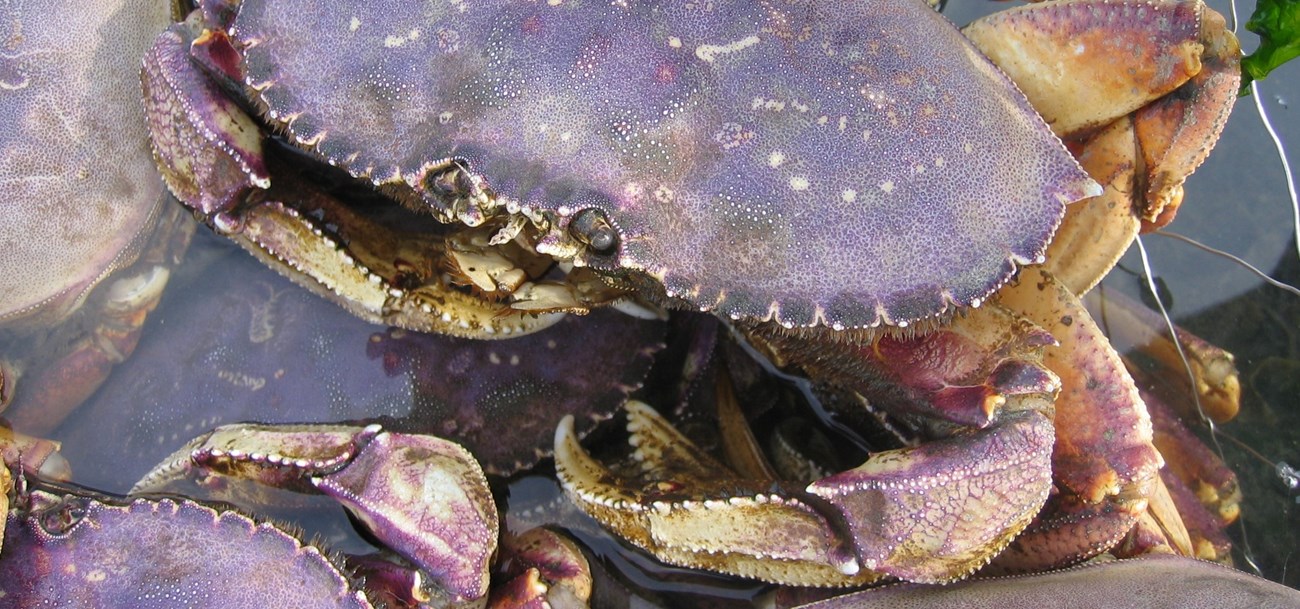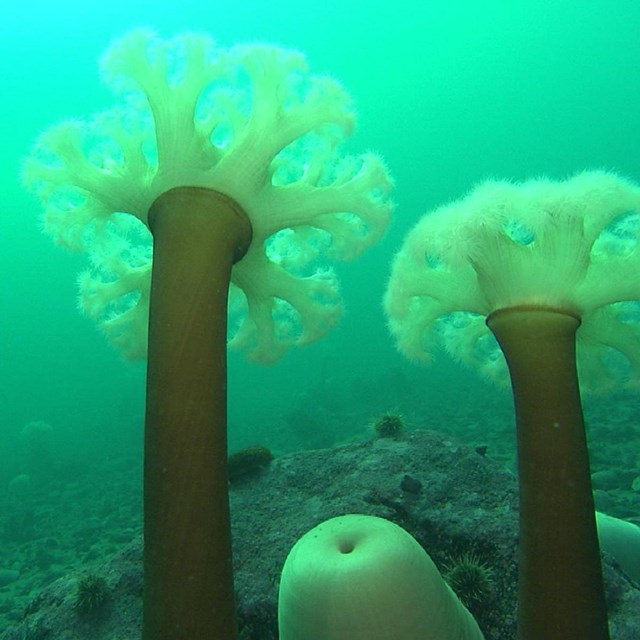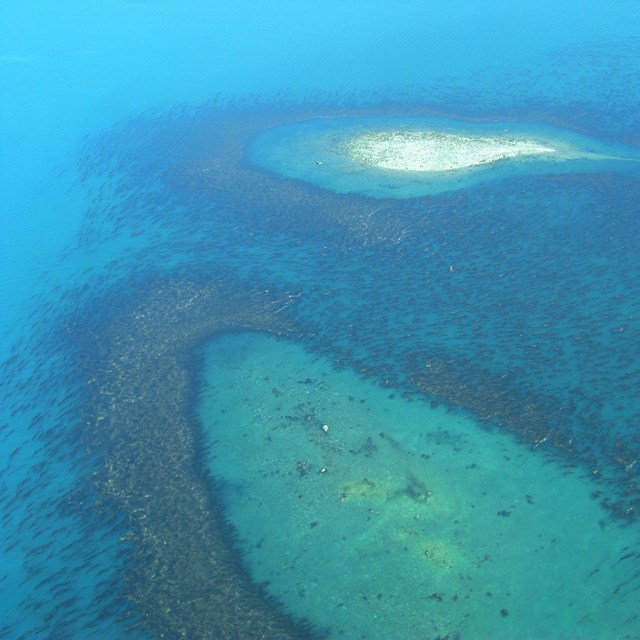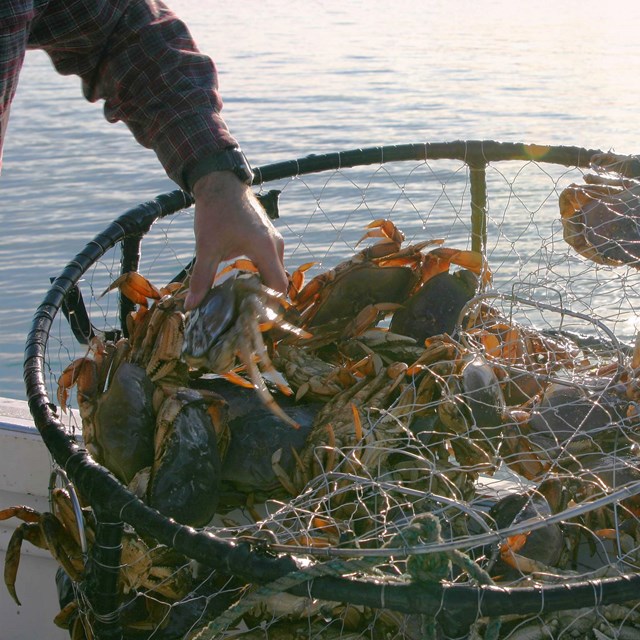Last updated: February 14, 2025
Article
Dungeness Crabs of Glacier Bay

Dungeness Crab Facts
- Dungeness crabs have purple tinged, grayish-brown backs with cream-colored undersides.
- Mature Dungeness crabs are typically 6"-7" across.
- Dungeness crabs have several pairs of appendages. Two pairs (antennae) are for touch and smell. A number of modified appendages act as a mouth, used for cutting, picking, sorting and pulverizing food. The pincers, the most recognizable appendage, are used for grasping, tearing and defense. Each crab has four pairs of walking legs. Appendages are also located on an up-tucked tail; the female uses these appendages to hold onto her eggs.
- Crabs are able to regenerate lost appendages.
- A sideways walker, a crab will push with four legs on one side and pull with the other side.
- They are named after one of their representative habitats - a shallow, sandy bay inside of Dungeness Spit on the south shore of the Straits of Juan de Fuca.
- Crabs have an outer shell, or exoskeleton, called a carapace.
- Dungeness crabs have broad, oval bodies covered by a hard chitinous shell.
- They have smaller, shorter legs in relation to their body size than other crabs of the area, and they have no spines on the top side of their carapaces (shells).
- The carapace does not grow in the continuous, gradual manner of animals with internal skeletons - such as fish and mammals.
- They can live between 8-13 years and reach a size of 10-plus inches.
- Within 2-3 years, crabs are sexually active. At 4-5 years, they have grown to the legal harvest size (6 ¼ across the shell and 2-3 pounds in weight).
The Molting Mechanism
Prior to and during molting, crabs absorb water into their body tissues, which expands the body to a larger size causing the shell to split. The soft, newly-molted crab emerges from the old shell and seeks shelter while its new shell hardens. Complete hardening of the new shell takes about 6 weeks for adult crabs. It takes a little longer for the crab to fully replace the absorbed water with new body tissue, such as muscle.Adult males and females in a population tend to molt at different times, so that the males will be hard-shelled and able to mate when the females molt. During the first 2 years (10–11 molts) the crabs shed their shell several times a year, increasing in size with every successive molt. After molting, the new, paper-thin shell is vulnerable to puncture, so the crab hides by burying itself in the sandy bottom for several days. Most males molt during the summer months but the time can vary greatly by area and year.
Habitat
Once grown, mature males that have recently molted can be found sometimes in large groups (aggregates). Aggregates can be found in depressions or trenches usually approximately 1 meter deep and 5 meters wide. These habitat features may offer increased protection from predation. The rarity of such features in the habitat may also explain why the crabs, usually solitary, gather there. These groups seem to suggest a selfish herd or schooling phenomenon in which individuals gain protection in numbers through greater watchfulness and confusion of predators. Another explanation for these groups can be found in the fact that in 3 recently observed male aggregates, the distance from the nearest known female assembly averaged 200 meters, a lot closer than would be expected to occur randomly. Juveniles live in intertidal and shallow subtidal areas, hiding underneath or among plants, rocks, shell debris and eelgrass beds. Juveniles also prefer cooler waters than adults. Adult crabs prefer eelgrass beds and sandy or muddy substrate. Breeding occurs in nearshore areas and females usually move to deeper water to hatch eggs.
Reproduction
When the female molts, she is ready to be mated with a male who protects her while mating. Mating occurs in the late spring or early summer. The eggs are not fertilized until the female extrudes them under her abdomen where they are carried for 3-5 months until hatching. A large female crab can carry 2.5 million eggs. Egg incubation tends to be much longer in Alaska than further south. The female crab stores the sperm until her eggs are fully developed. In Alaska, fertilization typically occurs in September.Many female crabs do not reproduce annually in Alaska. Larger females (greater than 141 mm in carapace width) are probably the group of females that do not reproduce annually, possibly because they don't molt as often and rely on stored sperm to fertilize their eggs. Egg-bearing females often congregate and bury themselves in areas of suitable substrate, sheltered from winter storms while they incubate their eggs.

Growth and Development
When hatched, the new crabs are planktonic and swim freely away from the female. Larval development takes from 4 months to a year in Alaska. In the larval stage, these babies are free-floating in the water column and are transported primarily by currents. There are 6 successive life stages (5 zoeae and 1 megalop) that occur before they enter the first juvenile stage and begin to resemble a miniature crab - ¼ to "dime-size." Female crabs grow more slowly than the males.
With claws and legs, the megalop is more recognizable as a young crab, but it still has a shrimp-like abdomen. Megalopae are relatively strong swimmers, moving at speeds up to 22 centimeters per second, and are typically present in surface waters only at dawn, dusk and night. During the day, they usually move down in the water column to a depth of at least 20 meters. In Glacier Bay, a significantly larger number of megalops were caught at high tides than at low tides, suggesting that late-stage larvae may be transported to nearshore areas with flooding tides.
Crabs can only grow by periodic shedding of their shell in a process called molting. The carapace does not grow in the continuous, gradual manner of animals with internal skeletons - such as fish and mammals. Instead crabs must regularly shed their exoskeletons in order to increase in size. This process is known as molting, and individuals typically increase in size by about 15 to 25 per cent with each molt. All the hard parts of the crab are shed as one piece. During a molt, the old shell splits at the back and along both sides, and the crab backs out of its shell. The opening in a molted shell closes up after the crab has exited. Young crabs, which put all their energy reserves into body growth, molt more frequently and to a relatively larger size than adult crabs, which devote more of their energy to reproduction.
Eat or Be Eaten!
Crab predators include other crab species, halibut, dogfish, sculpins, octopus and sea otters. Cannibalism may occur, particularly on young crabs during the first weeks after settlement to the bottom, or on newly molted crabs. Salmon and other fin fish feed on crab larvae when they are available in the plankton. Newly settled crabs have the highest survival rates in shallow waters, including the intertidal zone, presumably to avoid predators. They also require cooler waters.
Crabs are carnivores and their diet can include shrimp, mussels, small crabs, clams and worms.Dungeness crabs are foragers. They scavenge along the sea floor for organisms that live partly or completely buried in the sand.
Commercial Fishing
Extensive commercial fisheries began before Glacier Bay National Monument, Alaska, was established in 1925. During the 1990s, fisheries around the world collapsed. People began to wonder if certain fisheries would continue indefinitely. A growing body of scientific information suggests that "no-take marine reserves" could enhance the long-term sustainability of many fisheries and marine biodiversity. But, most of the data comes from studies in tropical areas rather than in high latitude regions such as Glacier Bay. Between 1970 and 1995, the harvest of Dungeness crabs for Glacier Bay and Icy Strait has ranged from 76,000 to 658,000 pounds.
Recently, commercial fishermen have harvested a large proportion of the legal Dungeness crabs living in Southeast Alaska. A Dungeness crab that can be legally harvested is defined by size and sex; i.e., any female crab or male crab with a carapace of less than 165 mm must be thrown back. As a result there has been a decrease in the maximum size of males in the population. Crustacean fisheries, such as the Dungeness crab fishery of Southeast Alaska, that are experiencing major declines are usually closed temporarily because, otherwise, the fishery would collapse altogether. Such closures normally remain in effect only until there is evidence that the crustaceans are coming back.
After Glacier Bay was closed to commercial fishing, the number and size of legal-sized male Dungeness crabs increased dramatically at the experimental sites.
-
 Beneath the SurfaceGlacier Bay Ocean
Beneath the SurfaceGlacier Bay OceanExplore the deep, cold waters of Glacier Bay.
-
 Changing SeasClimate Change in Glacier Bay
Changing SeasClimate Change in Glacier BayGlacier Bay is experiencing the effects of climate change.
-
 Fishing RegulationsCommercial Fishing in the Park
Fishing RegulationsCommercial Fishing in the ParkWhat kind of commercial fishing happens in Glacier Bay?
